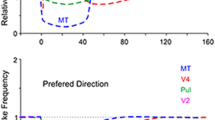Abstract.
The responses of neurons in the medial column of the inferior olive to translational and rotational optic flow were recorded from anaesthetized pigeons. Panoramic translational or rotational flowfields were produced by mechanical devices that projected optic flow patterns onto the walls, ceiling and floor of the room. The axis of rotation/translation could be positioned to any orientation in three-dimensional space such that axis tuning could be determined. Each neuron was assigned a vector representing the axis about/along which the animal would rotate/translate to produce the flowfield that elicited maximal modulation. Both translation-sensitive and rotation-sensitive neurons were found. For neurons responsive to translational optic flow, the preferred axis is described with reference to a standard right-handed coordinate system, where +x, +y and +z represent rightward, upward and forward translation of the animal, respectively (assuming that all recordings were from the right side of the brain). t(+y) neurons were maximally excited in response to a translational optic flowfield that results from self-translation upward along the vertical (y) axis. t(–y) neurons also responded best to translational optic flow along the vertical axis but showed the opposite direction preference. The two remaining groups, t(–x+z) and t(–x–z) neurons, responded best to translational optic flow along horizontal axes that were oriented 45° to the midline. There were two types of neurons responsive to rotational optic flow: rVA neurons preferred rotation about the vertical axis, and rH135c neurons preferred rotation about a horizontal axis at 135° contralateral azimuth. The locations of marking lesions indicated a clear topographical organization of the six response types. In summary, our results reinforce that the olivo-cerebellar system dedicated to the analysis of optic flow is organized according to a reference frame consisting of three approximately orthogonal axes: the vertical axis, and two horizontal axes oriented 45° to either side the midline. Previous research has shown that the eye muscles, vestibular semicircular canals and postural control system all share a similar spatial frame of reference.
Similar content being viewed by others
Author information
Authors and Affiliations
Additional information
Electronic Publication
Rights and permissions
About this article
Cite this article
Winship, I.R., Wylie, D.R. Responses of neurons in the medial column of the inferior olive in pigeons to translational and rotational optic flowfields. Exp Brain Res 141, 63–78 (2001). https://doi.org/10.1007/s002210100845
Received:
Accepted:
Issue Date:
DOI: https://doi.org/10.1007/s002210100845




